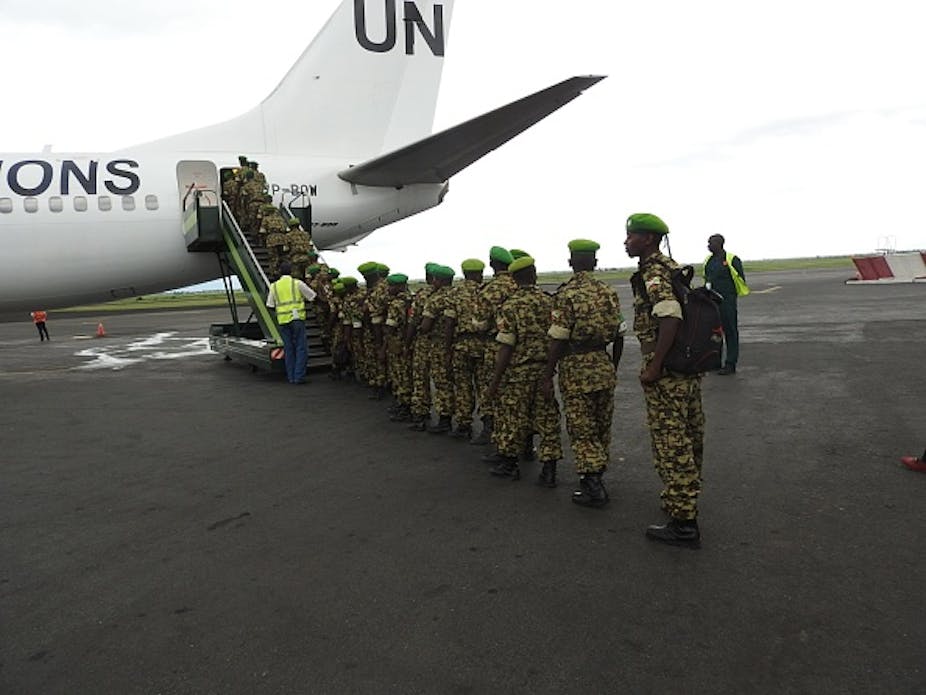The phased withdrawal of the African Union Transition Mission in Somalia (Atmis) began earlier this year and is scheduled to end in December 2024.
The withdrawal of African Union (AU) peacekeepers poses risks for Somalia. For one, it may reduce the pressure on al-Shabaab at a crucial time during the Somali government’s latest offensive. These risks cannot be completely eliminated but there are important steps the Somali authorities and the AU must take before the mission’s exit.
The withdrawal of the AU troops hands a battlefield and propaganda advantage to al-Shabaab. Beyond that, it reduces support for Somali forces trying to wage an offensive. There is also a risk that Somali forces garrisoned in former AU operating bases might be particularly vulnerable to al-Shabaab attack.
The AU Mission in Somalia arrived in Mogadishu in March 2007, eventually growing to a force of over 22,000 personnel by 2014. From December 2017, the force was gradually downsized. In 2022 it was renamed a transitional force, a signal that the AU was entering the last phase of its military deployment in Somalia.
In the next drawdown phase, 3,000 out of 17,500 peacekeepers should depart by the end of September.
To ensure a smooth departure, the Somali authorities and AU forces must accomplish several key tasks. Somalia must reform and strengthen its internal security. The AU must coordinate with Somali forces and partner with the United Nations to handle the difficult logistics of the exiting troops. If they both succeed, then it’s worth speculating about what is likely to happen after the AU peacekeepers leave.
Somalia’s key tasks
For the Somali authorities, the key political challenge is to finalise the structure of their national security architecture. This has been stuck in draft form since 2017 and was recently revised. It is crucial that the type and numbers of forces, as well as command and control, and financial relationships are clear and agreeable to both the federal government and federal member states. It will be impossible to conduct successful offensive campaigns unless the Somali federal and regional authorities are on the same page.
Second, Somalia and its regions must recruit more security personnel, principally soldiers for the Somali National Army as well as federal and local police officers. The stated goals are about 23,000 deployable soldiers and 32,000 police officers. This was formally recognised in UN Security Council resolutions in 2022 and 2023. But winning a war takes more than just fielding new, inexperienced personnel. The Somali army still lacks the supporting equipment, field mentoring, infrastructure and governing institutions it needs.
Finally, the Somali authorities must make significant progress in the war against al-Shabaab before the AU force leaves. President Hassan Sheikh’s goal of defeating al-Shabaab in five months is wildly optimistic. It’s also counterproductive because it frames the current offensive campaign as a sprint rather than the marathon it really is. For over a decade, the central military problem has not been ejecting al-Shabaab from settlements, it has been holding them afterwards and delivering a real peace dividend to the local population.
The AU’s key tasks
The AU has its own list of difficult tasks to ensure a smooth, phased withdrawal of peacekeepers.
Having withdrawn 2,000 troops in June, the AU’s immediate task is to identify and withdraw the next 3,000 by the end of September 2023. The soldiers will probably be drawn from across all the mission’s sectors and troop-contributing countries (Burundi, Djibouti, Ethiopia, Kenya and Uganda).
Second, the AU must work with the UN Support Office in Somalia to ensure that the logistics go smoothly. The logistical challenges are considerable and will involve many vehicles and aircraft moving troops and equipment. The largest portion of this activity will involve the handover of forward operating bases from the AU to the Somali security forces, and perhaps the closure of some bases. These will be particularly vulnerable to al-Shabaab attack after the handovers.
Simultaneously, the AU transitional force must continue to support the Somali Army’s offensive operations, currently underway on two fronts in central and southern Somalia.
Finally, the AU force must maintain its regular operations while preparing for the third drawdown of troops, scheduled for June 2024.
What next after the AU transitional force?
Assuming the transition of security responsibilities to the Somali authorities sticks to the official plan, then the AU force’s mandate will end by 2025. But this does not necessarily mean the end of international forces in Somalia. Security assistance programmes and operations by the United States, Turkey, the European Union, and the United Kingdom are unlikely to end abruptly when the AU force exits. If nothing else, an international security presence will remain in and around Mogadishu to protect the diplomatic community.
Nor will Somalia’s neighbours reduce their forces to zero. Indeed, earlier this year, Somalia’s neighbours agreed to provide additional troops to help the federal government fight al-Shabaab, a clear signal of what the period after the AU force might entail. So far, however, this commitment doesn’t appear to have been implemented.
The Somali federal government is hence likely to enter into bilateral security agreements with its neighbours. It is also probable that Somalia will ask Uganda to retain a security force in and around Mogadishu. This makes practical sense because Ugandan troops have over 16 years of experience fighting al-Shabaab. It would be very difficult for any other foreign country to replicate that. In this scenario, Burundi might be the only country whose troops leave Somalia when the mandate of the AU transitional force ends. If so, this would not represent a major strategic change in the dynamics of this long war.

